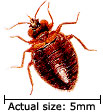Advanced Pest Control Services
(Part of the Sussex Technical Products Group)

Bedbugs
Adult bedbugs are 4-5 mm in length, about the size of a ladybird and reddish
brown in colour. They have long well developed walking legs with efficient
tarsal claws and prominent antennae project from the head adjacent to the
compound eyes.
Biology
Female bedbugs lay eggs throughout their life producing about 2-3 a day and
since they can live for many months can produce up to 400 eggs in their lifetime.
The eggs are very small – about 1 mm in length and are cemented to the
surfaces of the harbourages, often in large numbers. The first stage nymphs
(young) which hatch from the eggs are just over 1 mm in length and, like all
the nymphal stages, appear very similar to the adult stage except in the size
and colour. Early nymphal stages are lighter in colour and get progressively
darker. Bedbugs have well defined nesting sites or harbourages in which many
individuals from all the different life stages are found. This harbourage
is an essential part of the life cycle of the insect as this is where the
young bedbugs pick up the internal gut micro organisms which are essential
to their survival.
Distribution and Significance
Bedbugs are represented throughout the World. As they cannot fly they must
either crawl or be passively transported on clothes, furniture or commonly
luggage after visiting a hotel or hostel etc. They are able to survive many
months without feeding. Most infestations are found in bedrooms with the insects
hiding away in the cracks and crevices for most of the time and coming out
only at night to feed on the blood of their sleeping hosts. The hiding places
will be close to where the host sleeps; in the bed frame, mattress, bedside
furniture, skirting, behind wallpaper – anywhere that provides dark harbourage
during the daylight hours for these nocturnal creatures.
Bedbugs are not regarded as disease carriers, but their blood feeding can
cause severe irritation to some people. The bite often gives rise to a whitish
hard swelling which distinguishes is from a flea bite which leaves a dark
red spot surrounded by a reddened area.
Control
In all infestations, particularly those newly established in well kept houses,
an attempt should be made to determine the source of the infestation, so that
proper control
measures can be taken. High standards of hygiene and housekeeping are unlikely
to provide an adequate method of control, but will reveal the presence of
bedbugs at an early stage making control easier. If they are suspected a close
inspection of the bed, headboard, mattress etc, should reveal their presence.
A pyrethroid based aerosol sprayed lightly around these areas may help to
reveal them as they will be driven from their resting sites and harbourages.
Blackish spots of bug excrement around the nesting sites will also indicate
their presence. Infected sheets etc should be laundered and rooms thoroughly
vacuumed and cleaned. Particular attention should be paid to removing dust,
fluff and debris from cracks, crevices, seams of fabric, buttons on mattress
etc. To eradicate the infestation it will be necessary to treat the premises
thoroughly vacuumed with suitable insecticides including the bed, floors,
furniture and other harbourages. A professional pest control company should
be used as the detection and thorough treatment of all hiding places is a
job that requires experience.
4 Frenchgate Close , Eastbourne. East Sussex. BN22 9EX. United Kingdom.
Booking Hotline and Technical advice 07767148143 or 01323 365124 Office
meshsales@skylord.f2s.com
Copyright © 2014 Sussex Technical Products